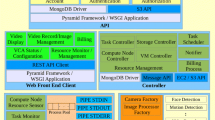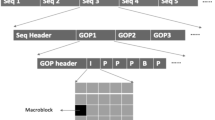Abstract
The next generation video surveillance systems are expected to face challenges in providing computation support for an unprecedented amount of video streams from multiple video cameras in a timely and scalable fashion. Cloud computing offers huge computation resources for large-scale storage and processing on demand, which are deemed suitable for video surveillance tasks. Cloud also provides quality of service guaranteed hardware and software solutions with the virtual machine (VM) technology using a utility-like service costing model. In cloud-based video surveillance context, the resource requests to handle video surveillance tasks are translated in the form of VM resource requests, which in turn are mapped to VM resource allocation referring to physical server resources hosting the VMs. Due to the nature of video surveillance tasks, these requests are highly time-constrained, heterogeneous and dynamic in nature. Hence, it is very challenging to actually manage the cloud resources from the perspective of VM resource allocation given the stringent requirements of video surveillance tasks. This paper proposes a computation model to efficiently manage cloud resources for surveillance tasks allocation. The proposed model works on optimizing the trade-off between average service waiting time and long-term service cost, and shows that long-term service cost is inversely proportional to high and balanced utilization of cloud resources. Experiments show that our approach provides a near-optimal solution for cloud resource management when handling the heterogeneous and unpredictable video surveillance tasks dynamically over next generation network.









Similar content being viewed by others
References
Aisopos F, Tserpes K, Varvarigou T (2013) Resource management in software as a service using the knapsack problem model. Int J Prod Econ 141(2):465–477
Armstrong R, Hensgen D, Kidd T (1998) The relative performance of various mapping algorithms is independent of sizable variances in run-time predictions. In: Heterogeneous computing workshop, 1998.(HCW 98) proceedings. 1998 seventh. pp. 79–87. IEEE
Atherton DP (1999) Pid controller tuning. J Comput Control Eng 10(2):44–50
Beloglazov A, Abawajy J, Buyya R (2012) Energy-aware resource allocation heuristics for efficient management of data centers for cloud computing. Futur Gener Comput Syst 28(5):755–768
Calheiros RN, Ranjan R, Beloglazov A, De Rose CA, Buyya R (2011) Cloudsim: a toolkit for modeling and simulation of cloud computing environments and evaluation of resource provisioning algorithms. Softw: Pract Experience 41(1):23–50
Calheiros RN, Ranjan R, Buyya R (2011) Virtual machine provisioning based on analytical performance and qos in cloud computing environments. In: Parallel processing (ICPP), 2011 international conference on. pp. 295–304. IEEE
Chen M (2014) NDNC-BAN: Supporting rich media healthcare services via named data networking in cloud-assisted wireless body area networks. Inf Sci 284:142–156
Chen M, González S, Cao H, Zhang Y, Vuong ST (2013) Enabling low bit-rate and reliable video surveillance over practical wireless sensor network. J Supercomput 65(1):287–300
Chen M, Hao Y, Li Y, Lai CF, Wu D (2015) On the computation offloading at ad hoc cloudlet: architecture and service modes. IEEE Commun Mag 53(6):1824
Chen M, Zhang Y, Hu L, Taleb T, Sheng Z (2015) Cloud-based wireless network: virtualized, reconfigurable, smart wireless network to enable 5g technologies. Mob Netw Appl 20(6):704–712
Chen M, Zhang Y, Li Y, Hassan M, Alamri A (2015) Aiwac: affective interaction through wearable computing and cloud technology. IEEE Wirel Commun 22(1):2027
Chen M, Zhang Y, Li Y, Mao S, Leung V (2015) Emc: Emotion-aware mobile cloud computing in 5g. IEEE Netw 29(2):3238
Chen YL, Chen TS, Huang TW, Yin LC, Wang SY, cker Chiueh T (2013) Intelligent urban video surveillance system for automatic vehicle detection and tracking in clouds. In: Advanced information networking and applications (AINA), 2013 IEEE 27th international conference on, pp 814–821
Cucchiara R (2005) Multimedia surveillance systems. In: Proceedings of the third ACM international workshop on video surveillance & sensor networks. pp. 3–10. VSSN ’05, ACM
Ferreto TC, Netto MA, Calheiros RN, De Rose CA (2011) Server consolidation with migration control for virtualized data centers. Futur Gener Comput Syst 27(8):1027–1034
Freund RF, Gherrity M, Ambrosius S, Campbell M, Halderman M, Hensgen D, Keith E, Kidd T, Kussow M, Lima JD et al (1998) Scheduling resources in multi-user, heterogeneous, computing environments with smartnet. In: Heterogeneous computing workshop, 1998.(HCW 98) proceedings. 1998 seventh. pp. 184–199. IEEE
Goiri Í., Berral JL, Fitó JO, Julià F, Nou R, Guitart J, Gavaldà R, Torres J (2012) Energy-efficient and multifaceted resource management for profit-driven virtualized data centers. Futur Gener Comput Syst 28(5):718–731
Han Q, Liang S, Zhang H (2015) Mobile cloud sensing, big data, and 5g networks make an intelligent and smart world. IEEE Netw 29(2):4045
Hassan MM, Hossain MS, Sarkar AJ, Huh EN (2014) Cooperative game-based distributed resource allocation in horizontal dynamic cloud federation platform. Inf Syst Front 16(4):523–542
He J, Wu D, Xie X, Chen M, Li Y, Zhang G (2015) Efficient upstream bandwidth multiplexing for cloud video recording services IEEE Transactions on Circuits and Systems for Video Technology PP(99)
Hossain MA (2013) Analyzing the suitability of cloud-based multimedia surveillance systems. In: Proceedings of the 15th IEEE international conference on high performance computing and communications (HPCC 2013)
Hossain MA (2014) Framework for a cloud-based multimedia surveillance system. Int J Distrib Sens Netw 2014(1):11
Hossain MA, Atrey PK, Saddik AE (2011) Modeling and assessing quality of information in multisensor multimedia monitoring systems. ACM Trans Multimed Comput Commun Appl (TOMCCAP) 7(1):3
Kumar K, Lu YH (2010) Cloud computing for mobile users: Can offloading computation save energy? Computer 43(4):51–56
Lai G, Song H, Lin X (2010) A service based lightweight desktop virtualization system. In: Service sciences (ICSS), 2010 international conference on. pp. 277–282. IEEE
Lin CF, Yuan SM, Leu MC, Tsai CT (2012) A framework for scalable cloud video recorder system in surveillance environment. In: Ubiquitous intelligence & computing and 9th international conference on autonomic & trusted computing (UIC/ATC), 2012 9th international conference on. pp. 655–660. IEEE
Lin W, Qi D (2010) Research on resource self-organizing model for cloud computing. In: Internet technology and applications, 2010 international conference on. pp. 1–5. IEEE
Maheswaran M, Ali S, Siegel HJ, Hensgen D, Freund RF (1999) Dynamic mapping of a class of independent tasks onto heterogeneous computing systems. J Parallel Distrib Comput 59(2):107–131
Nan X, He Y, Guan L (2011) Optimal resource allocation for multimedia cloud based on queuing model. In: Multimedia signal processing (MMSP), 2011 IEEE 13th international workshop on. pp. 1–6. IEEE
Nan X, He Y, Guan L (2012) Optimal allocation of virtual machines for cloud-based multimedia applications. In: Multimedia signal processing (MMSP), 2012 IEEE 14th international workshop on. pp. 175–180. IEEE
Nan X, He Y, Guan L (2012) Optimal resource allocation for multimedia cloud in priority service scheme. In: Circuits and systems (ISCAS), 2012 IEEE international symposium on. pp. 1111–1114. IEEE
Neal D, Rahman S (2012) Video surveillance in the cloud? Int J Crypt Inf Secur (IJCIS) 2(3):119
Nguyen Van H, Dang Tran F, Menaud JM (2009) Autonomic virtual resource management for service hosting platforms. In: Proceedings of the 2009 ICSE workshop on software engineering challenges of cloud computing. pp. 1–8. IEEE computer society
Paul AK, Park JS (2013) Multiclass object recognition using smart phone and cloud computing for augmented reality and video surveillance applications. In: Informatics, electronics & vision (ICIEV), 2013 international conference on. pp. 1–6. IEEE
Ren S, van der Schaar M (2012) Energy-efficient community cloud for real-time stream mining. In: Decision and control (CDC), 2012 IEEE 51st annual conference on. pp. 424–429. IEEE
Saini M, Atrey PK, Kankanhalli MS (2013) Workload modeling for multimedia surveillance systems. In: Emerging paradigms in machine learning. Springer, pp 419–440
Saini M, Wang X, Atrey PK, Kankanhalli M (2012) Adaptive workload equalization in multi-camera surveillance systems. IEEE Trans Multimedia 14(3):555–562
Teng F, Magoules F (2010) Resource pricing and equilibrium allocation policy in cloud computing. In: Computer and information technology (CIT), 2010 IEEE 10th international conference on. pp. 195–202. IEEE
Valera M, Velastin S (2005) Intelligent distributed surveillance systems: a review. Vis, Image Signal Process IEE Proc - 152(2):192–204
Wei G, Vasilakos AV, Zheng Y, Xiong N (2010) A game-theoretic method of fair resource allocation for cloud computing services. J Supercomput 54(2):252–269
Wen H, Hai-ying Z, Chuang L, Yang Y (2011) Effective load balancing for cloud-based multimedia system. In: Electronic and mechanical engineering and information technology (EMEIT), 2011 international conference on. vol. 1, pp. 165–168. IEEE
Xiong Y, Wan S, She J, Wu M, He Y, Jiang K (2016) An energy-optimization-based method of task scheduling for a cloud video surveillance center. J Netw Comput Appl 59:63–73
Yi S, Jing X, Zhu J, Zhu J, Cheng H (2012) The model of face recognition in video surveillance based on cloud computing. In: Advances in computer science and information engineering. Springer, pp 105–111
Young DP, Ferryman JM (2005) Pets metrics: On-line performance evaluation service. In: Visual surveillance and performance evaluation of tracking and surveillance, 2005. 2nd joint IEEE international workshop on. pp. 317–324. IEEE
Acknowledgments
The authors extend their appreciation to the Deanship of Scientific Research at King Saud University for funding this work through the research group project No. RGP-VPP-049.
Author information
Authors and Affiliations
Corresponding author
Rights and permissions
About this article
Cite this article
Hossain, M.A., Song, B. Efficient Resource Management for Cloud-enabled Video Surveillance over Next Generation Network. Mobile Netw Appl 21, 806–821 (2016). https://doi.org/10.1007/s11036-016-0699-3
Published:
Issue Date:
DOI: https://doi.org/10.1007/s11036-016-0699-3




